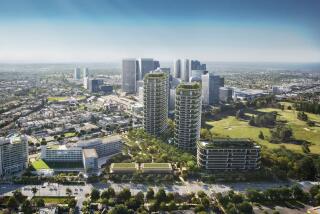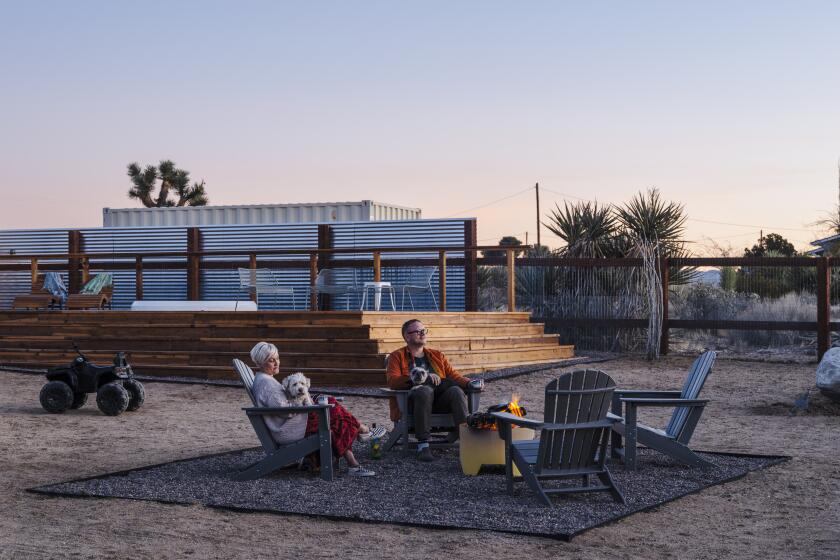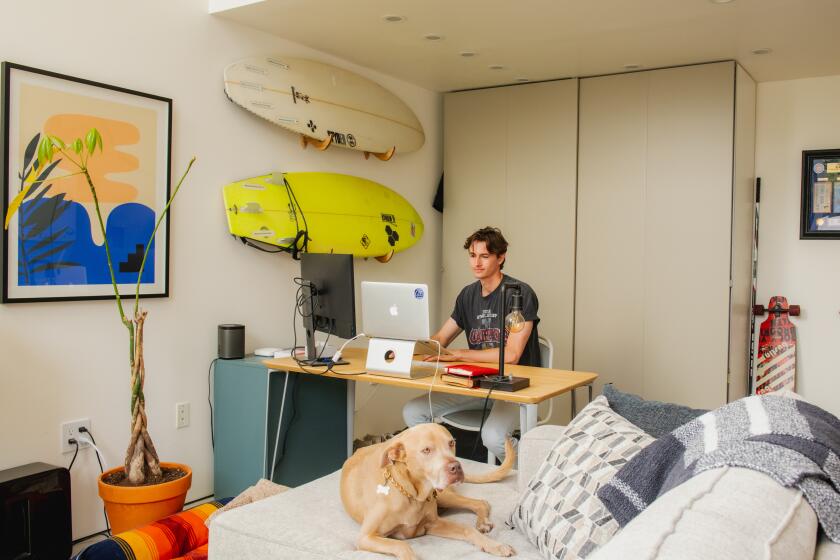Downtown L.A. Looks to Lofts for Possible Revival
Take the increasing national trend for people to work at least part time at home. Add the long unfulfilled desire to attract more residents to downtown Los Angeles. Mix in the sad inventory of outdated, and mainly empty, office buildings.
Those are some ingredients in a recipe to turn downtown’s business district into a neighborhood where World Wide Web page designers, video techies and real estate attorneys can live and work in spacious lofts.
But with several key components still missing, Los Angeles officials are now following the example of cities elsewhere in writing a ‘90s cookbook for possible urban revival.
New zoning and building codes and financial incentives are being drafted by a city task force, with the aim of encouraging conversion of an estimated 200 pre-1974 office structures into live-work spaces. Similar efforts are proving successful in Denver, San Francisco and lower Manhattan as the loft lifestyle extends from industrial warehouses into high-rise towers.
“Perhaps for the first few projects, this is going to be a hard sell on a lot of fronts. But I think ultimately it will be a booming market,” said Lesley Elwood, a consultant for the Los Angeles Community Redevelopment Agency who is on the live-work task force.
The proposals by themselves won’t restore life to what now are ghostly streets after dark, according to Alan Bell, a Los Angeles city planner on the multi-departmental panel. But without the reforms, he said, developers who want to turn the 12-story buildings into residences are doomed to a “Kafkaesque nightmare of rules and regulations,” and the history of failures along 7th Street, Broadway and Spring Street will continue.
At a time when there are rental bargains to be had in new skyscrapers, the only remaining tenants in many older downtown structures are ground-floor shops. So the best hope for those outmoded office buildings may be live-work conversions, experts say. Rentals are thought more likely to succeed than condominiums.
Currently, such a switch to residential use would trigger myriad city codes designed more for new homes or apartments than for lofts being carved out of 1920s towers with marble-lined lobbies and double-height windows. The regulations involve such issues as the proper amount of parking spaces, limits on the number of residences per building lot, the need for sound insulation and fire safety procedures.
By persuading the City Council to adapt and waive some rules, the task force hopes to reduce developers’ costs and kick-start a trend in central downtown and along the Figueroa Street corridor toward USC. If successful, the live-work loft effort might be extended later to Hollywood, the Wilshire district and elsewhere, officials said.
The City Council recently gave a preliminary endorsement to the plan and sent it to committee for more study. Among other things, the council suggested that the city seek property tax relief from the state for live-work projects downtown.
Tax abatement and code changes have succeeded around Manhattan’s Wall Street area, where about 7,000 residential units are expected in older high-rises within five years, according to Tristan Ashby of the Alliance for Downtown New York. Since a 1995 rule change, “We are seeing a lot more activity,” he said.
The sprawling and outdoorsy nature of Los Angeles presents different marketing challenges than do the skyscraper canyons of Wall Street. The anti-downtown bias of many Angelenos is also a hurdle, prompted by issues of security, dirty streets and the lack of full-service supermarkets. But officials contend that the timing may be right for an experiment, considering such catalysts as a new sports arena and cathedral, both now in the planning stages.
As proof that local reforms can help, Los Angeles leaders point to the 1981 ordinance that allowed artists to legally reside in low-rise industrial warehouses, mainly on the east side of downtown. While the art scene cooled during the subsequent recession, an estimated 2,000 people still live in those lofts.
With the new effort aimed at office buildings that average 12 stories, different safety concerns must be addressed. The potential tenants might be somewhat different as well. In addition to artists, the new lofts could attract “a wide spectrum of workers in the multimedia industry and in entrepreneurial businesses of all kinds,” according to a recent report for the CRA.
The report by the Live/Work Services firm evaluated 20 buildings on such issues as floor plans, elevators, structural soundness and location.
“It made us really sad to do this survey. It was depressing to see all that beautiful space going to waste,” recalled Jon Peterson, one of the study’s authors. But the potential for revival is strong, he added.
Some buildings scored poorly. Yet the study gave high marks to the 1926 Subway Terminal Building, 12 stories high with a now-blocked trolley tunnel in the basement. A replica of Rodin’s statue “The Thinker” sits in the marble-pillared lobby. Located at 417 S. Hill St., at the foot of Bunker Hill, the mainly empty building might one day hold more than 150 live-work units, many with enormous bands of windows and fine views.
Whether that is economically feasible is uncertain, said Duane H. Cameron, president of System Property Development Co., which purchased the building last year for $2.5 million and is studying the costs of residential and office use. “The new ordinance would be important to us,” he said.
The first high-rise loft project downtown was supposed to be in the Roosevelt Building, a handsome 12-story structure at 727 W. 7th St., where office occupancy now stands at 20%. A Dallas firm’s plan to convert it into live-work space collapsed last year because of financial problems, said people close to the deal. Now a Denver-based company is looking to turn the Roosevelt into a long-stay residential hotel.
Another group, involving business people who helped revive San Diego’s Gas Lamp District, hopes to rewire and renovate the El Dorado Hotel in the 400 block of Spring Street into a model of live-work for the computer and multimedia industries.
Two years ago, developer Ira Yellin, with $44 million in bonds backed by the CRA and Metropolitan Transportation Authority, constructed 121 subsidized and market-rate apartments plus shops, offices and a parking structure at the historic Million Dollar Building and above the renovated Grand Central Market at Broadway and 3rd Street. All but two units--not live-work lofts but somewhat traditional apartments with 10-foot ceilings--are now rented in the $64-million project, a representative said.
In a tighter fiscal climate, such major public subsidies are not likely for live-work conversions. But the recent study suggested that the city might fund a pioneer program to reduce developers’ mortgage rates by 2% for the first 1,000 live-work lofts. “We consider 1,000 new units sufficient to create this critical mass,” the study stated.
Yet any effort to attract even that many new residents to downtown faces skepticism.
While most condominiums and rental apartment buildings on Bunker Hill and in the South Park area are occupied at near capacity, the number of buildings is far below what city planners had hoped for.
A particular sore point is the failed attempt to transform gritty Spring Street. To much fanfare, the Premiere Towers, 120 units carved out of historic bank and office buildings at 6th Street, was opened with CRA subsidies in 1984. After disappointing condominium sales and continuing problems with homelessness on nearby streets, the building today stands half empty as a rental project. According to a CRA official, the agency is negotiating buyouts with remaining condo owners.
But the live-work rental concept may cause people to take another look at downtown, real estate brokers say. Developers may be lured by the low prices of old office buildings and residents by the expansive loft spaces.
Seismic and fire safety should not be sacrificed, stressed Raymond Chan, the Department of Building and Safety representative on the task force. “We are trying to be as lenient as possible from an economic standpoint, but we will still try to maintain a high level of safety in all these buildings,” he said.
For example, the city might relax the rules requiring extra sound insulation between units and leave that up to the developers’ judgment. If windows to the street can be opened easily, requirements for smoke removal vents might be eased. Adjacent parking spaces won’t be required, although savvy developers will probably offer spots nearby. And residential density rules that might keep some floors empty would be waived.
New standards are being considered as well to ensure that the buildings aren’t turned into single-room occupancy hotels or sweatshops. The average minimum size of a building’s units must be 750 square feet, according to task force proposals. And massage parlors, adult entertainment, tattoo studios, welding shops and veterinarians would be banned.
Craig Swanson, a downtown real estate broker with Aston Partners, agreed that financial and zoning incentives are needed, particularly to ease the costs of seismic strengthening. While he conceded that only a small share of Angelenos might want to live downtown, Swanson predicted that could be enough. “I think it’s a diverse enough city for the market to be successful,” he said.






